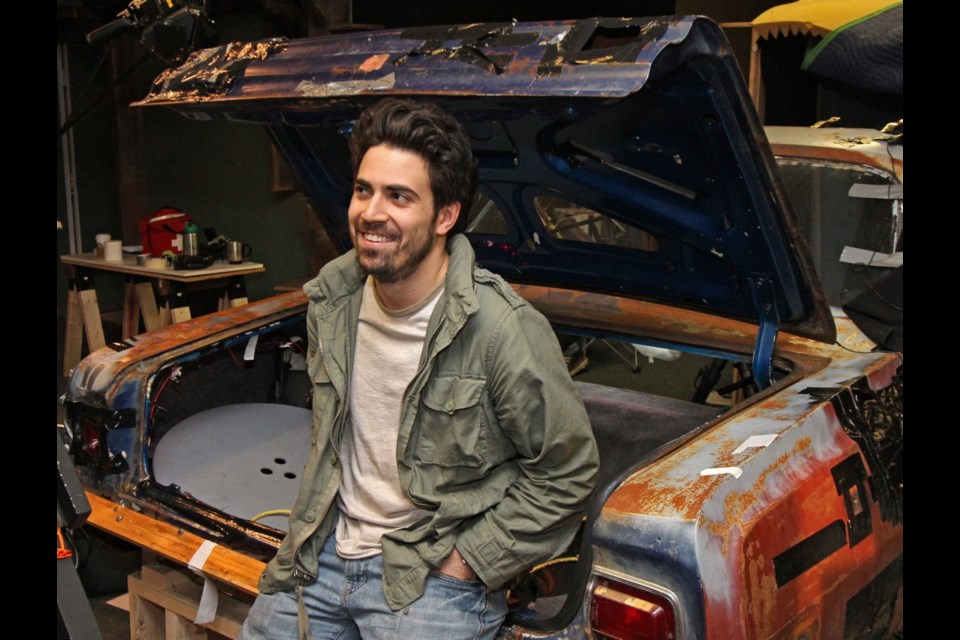Kayvon Kelly has had a lot of sleepless nights lately. No wonder. He’s been locked in the trunk of a car for eight days.
“It’s very claustrophobic,” recalled Kelly, 28, in the former home of McLarty’s Gifts and Furnishings in Sidney. “I’ve been finding my nights are still very hard, where I feel I’m still inside the thing.”
There was lots of rocking and rolling in the abandoned Third Street retail space, but not the musical kind. The Canadian College of Performing Arts grad was about to climb back into the severed trunk of a 1966 Chevelle to film a scene for Trunk.
The “rocking” was courtesy of “truck wrangler” Brian Paisley. The writer and producer rocked the spring-mounted rust-bucket on cue once director Martin de Valk and his dream team were ready to roll.
In what Paisley and creative collaborator Keith Digby term a “claustrophobic thriller,” Kelly, 28, plays a man locked in the trunk. Its driver played by Johanna Newmarch, seen only in glimpses, seeks to avenge her daughter’s murder.
The film keeps the audience guessing on the road to a murder scene where the reluctant passenger’s fate will be revealed. Is he an undercover cop who can help the vengeful driver find her daughter’s killer as he claims, or the murderer?
As in movies like Phone Booth and Buried, Trunk is essentially a single-set drama. It takes place in the trunk except for a sequence at Durrance Lake, where Kelly wore a wetsuit underneath his clothing.
The watery action was matched with footage shot in a large water tank built by production designer David Springbett in the makeshift film studio that also houses a construction workshop and editing suite.
“It’s a bit of a Star Trek thing where things aren’t actually happening, but I make it look like it is,” Kelly says before shooting a sequence in which he desperately tries to tie himself to a spare tire.
“There’s a lot of reaction to someone who’s driving and not being able to see that person,” Digby says. “It’s like Kayvon’s doing the movie and Johannah’s doing the radio play.”
The shoestring budget and constrained scenario called for considerable creative ingenuity.
“We had to stay in that trunk,” said de Valk, re-teaming with director of photography Sean White, his collaborator on the Leo Award-winning documentary series Back in the Day: On the Mighty Fraser.
He laughs as he recalls a question White asked before realizing how small the “set” was.
“He said, ‘;Can I get into the trunk and do an over-the-shoulder?’ ” said de Valk, whose concept called for 14 camera holes to be punched into the trunk’s exterior, including one left when Kelly’s character kicks out the speaker box.
“My biggest fear came once we were in the building and kept seeing that trunk get smaller and smaller,” Paisley said.
Adds Digby: “We saw it as this huge play space but when we got in there we were glad we got an actor who wasn’t six-foot-five.”
White and B-camera operator Rory Lambert used two high-end digital cameras to film through bullet holes and other crevices.
“The whole film takes place in the dark, so the challenge was how to make it interesting, dramatic and dynamic using only two or three light sources,” said White, whose interiors were illuminated using bicycle lights and the car’s rewired brake light.
To create the illusion the vehicle is moving past various backgrounds at different times, White shot footage while driving home to Tofino with his wife, photographer Deddeda Stemler. He then used a projector to beam the different loops of visuals from a laptop onto a tiny makeshift screen to make it appear light is filtering in.
The “third character,” as de Valk puts it, is Tim Archer’s soundscape using stragetically located microphones. “I’ve got to have a mike in every position he could be in and balance it later,” said the Imax sound designer (Bugs!), explaining how he captures a symphony of creaks, groans, screeching tires and engine sunds. “I can’t follow him around with a mike.”
Trunk was conceived as an opportunity for Digby, Paisley and de Valk to showcase their feature- film credibility.
“We were frustrated because we weren’t getting our scripts made,” said Paisley, the Belfast-born writer of the film-noir drama Lies Like Truth. “We said the only way we’re going to get this done is to do it ourselves.”
Digby, the screenwriter and theatre director who with partner Cythnia Pronick is co-artistic director of Langham Court Theatre, said it wasn’t as if producers weren’t telling them their scripts weren’t great.
“That’s what’s most frustrating, that thing about how you can starve to death with encouragement in this business.”
It also gave de Valk, best known for his documentary work, a chance to showcase his feature-film chops.
Digby and Paisley began fleshing out Digby’s original story idea two years ago. After Digby went to France for seven months they communicated by Skype. Then de Valk came on board, making changes to match his visual concept.
“They made it so much better I’ve almost forgiven them,” deadpans Digby.
The challenge, said de Valk, was finding ways to visualize the ensuing ‘;man and woman’ concept.
“I’m a visual thinker,” he said. “If I hear a line, I visualize how it will sound and look.”
Don’t expect deep messages or metaphors in Trunk, say its filmmakers, known for more ambitious, thought-provoking fare.
“We deliberately set out to create a genre film,” says Paisley. “It is what it is. It’s a ride.”



